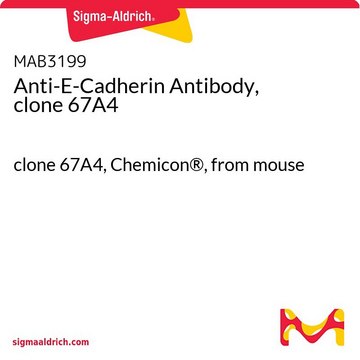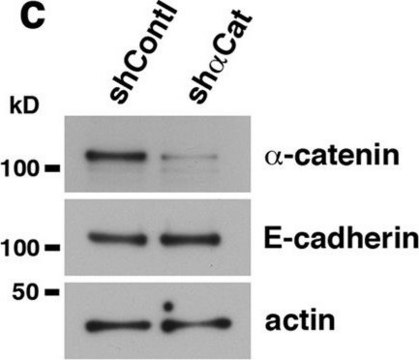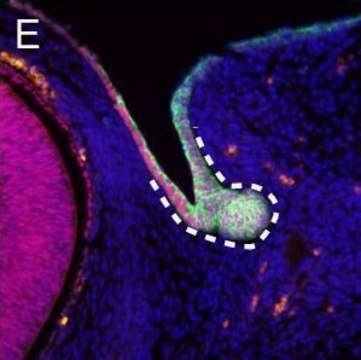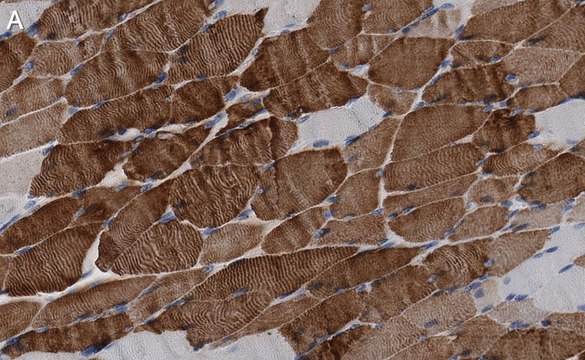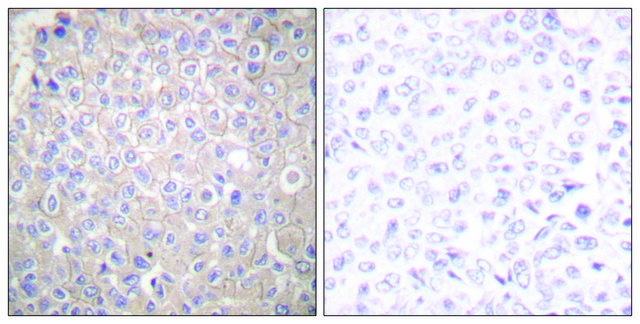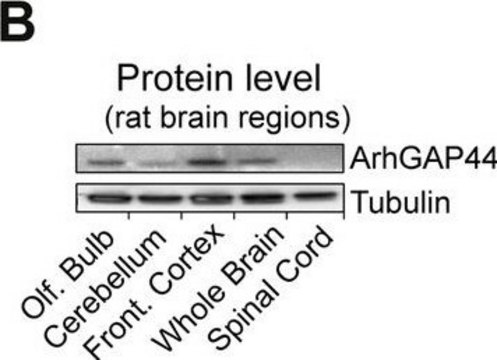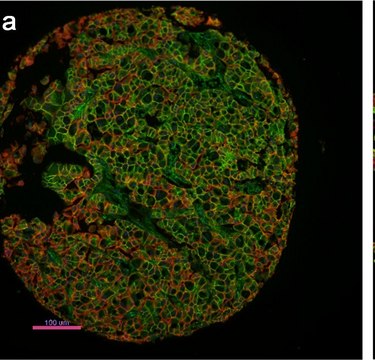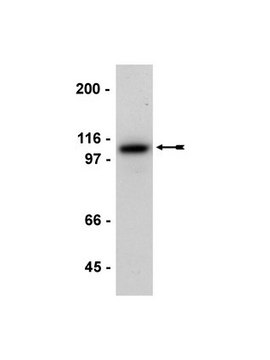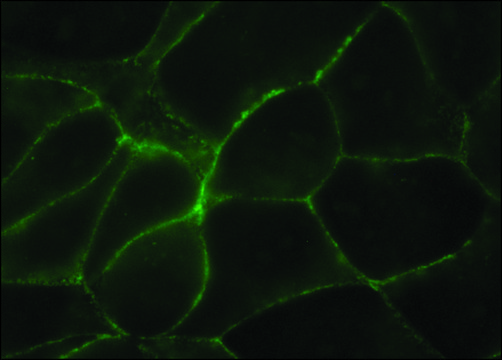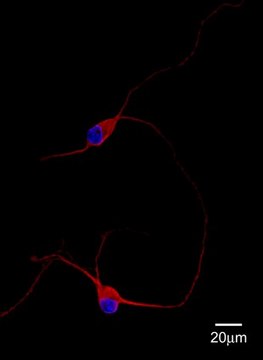一般描述
We are committed to bringing you greener alternative products, which adhere to one or more of The 12 Principles of Green Chemistry.This antibody is Preservative-free, produced without the harm or sacrifice of animals and exceptionally stable to allow for ambient shipping and storage if needed and thus aligns with "Waste Prevention", "Designing Safer Chemicals" and "Design for Energy Efficiency".
Click here for more information.
ZooMAb® antibodies represent an entirely new generation of recombinant monoclonal antibodies.
Each ZooMAb® antibody is manufactured using our proprietary recombinant expression system, purified to homogeneity, and precisely dispensed to produce robust and highly reproducible lot-to-lot consistency. Only top-performing clones are released for use by researchers. Each antibody is validated for high specificity and affinity across multiple applications, including its most commonly used application. ZooMAb® antibodies are reliably available and ready to ship when you need them.
特异性
Clone 1G14 is a ZooMAb® Rabbit recombinant monoclonal antibody that specifically detects E-cadherin. It targets an epitope within 13 amino acids from the C-terminal half.
免疫原
KLH-conjugated linear peptide corresponding to 13 amino acids from the C-terminal region of human E-Cadherin.
应用
Quality Control Testing
Evaluated by Western Blotting in A431 cell lysate.
Western Blotting Analysis: A 1:10,000 dilution of this antibody detected E-Cadherin in A431 cell lysate.
Tested applications
Western Blotting Analysis: A 1:10,000 dilution from a representative lot detected E-Cadherin in HeLa cell lysate.
Affinity Binding Assay: A representative lot of this antibody bound E-Cadherin peptide with a KD of 7.2 x 10-7 in an affinity binding assay.
Immunohistochemistry (Paraffin) Analysis: A 1:100 dilution from a representative lot detected E-Cadherin in human small intestine tissue sections.
Flow Cytometry Analysis: 1 μg from a representative lot detected E-Cadherin in Hela cells.
Note: Actual optimal working dilutions must be determined by end user as specimens, and experimental conditions may vary with the end user
目标描述
Cadherin-1 (UniProt: P12830; also known as CAM 120/80, Epithelial cadherin, E-cadherin, Uvomorulin, CD324) is encoded by the CDH1 (also known as CDHE, UVO) gene (Gene ID: 999) in human. Cadherins are calcium-dependent cell adhesion molecules that participate in cell-cell adhesion during embryogenesis, development, organogenesis, and differentiation. It also promotes metastasis in diverse models of invasive ductal carcinomas. E-cadherin is a single-pass type I membrane glycoprotein that is mainly expressed in non-neural epithelial tissues. It is synthesized with a signal peptide (aa 1-22) and a propeptide (aa 23-154) that are subsequently cleaved off to produce the mature form that contains an extracellular domain (aa 155-709), a transmembrane domain (aa 710-730), and a cytoplasmic domain (aa 731-882). N-glycosylation at Asn-637 is shown to be essential for its expression, folding, and trafficking. E-cadherin is known to contain five cadherin domains. Three calcium ions are usually bound at the interface of each cadherin domain and rigidify the connections, imparting a strong curvature to the full-length ectodomain. Post-translationally it can be cleaved into three chains: E-Cad/CTF1 (aa 701-882); E-Cad/CTF2 (aa 732-882); and E-Cad/CTF3 (aa 751-882). During apoptosis or with calcium influx, it is cleaved by a membrane-bound metalloproteinase (ADAM10; at residues 700-701), which causes disruption of cell-cell adhesion and the subsequent release of b-catenin into the cytoplasm. The residual membrane-tethered cleavage product is then rapidly degraded via an intracellular proteolytic pathway. It can also be cleaved by PS1/g-secretase (at residues 731-732) and this cleavage promotes disassembly of adherens junctions. Caspase 3 can cleave it at residues 750-751, which releases the cytoplasmic tail resulting in disintegration of the actin microfilament system. This ZooMAb® recombinant monoclonal antibody, generated by our propriety technology, offers significantly enhanced specificity, affinity, reproducibility, and stability over conventional monoclonals. (Ref.: PadmanabanV., et al (2019). Nature. 537(7774); 439-444; Marambaud, M., et al. (2002). EMBO J. 21(8); 1948-1956; Steinhausen, U., et al. (2001). J. Biol. Chem. 276(7); 4972-4980; Ito, K., et al. (1999). Oncogene. 18(50); 7080-7090).
外形
Purified recombinant rabbit monoclonal antibody IgG, lyophilized in PBS, 5% Trehalose, normal appearance a coarse or translucent resin. The PBS/trehalose components in the ZooMAb formulation can have the appearance of a semi-solid (bead like gel) after lyophilization. This is a normal phenomenon. Please follow the recommended reconstitution procedure in the data sheet to dissolve the semi-solid, bead-like, gel-appearing material. The resulting antibody solution is completely stable and functional as proven by full functional testing. Contains no biocide or preservatives, such as azide, or any animal by-products. Larger pack sizes provided as multiples of 25 μL.
重悬
300 μg/mL after reconstitution at 25 μL per vial. Please refer to guidance on suggested starting dilutions and/or titers per application and sample type.
储存及稳定性
Recommend storage of lyophilized product at 2-8°C; Before reconstitution, micro-centrifuge vials briefly to spin down material to bottom of the vial; Reconstitute each vial by adding 25 μL of filtered lab grade water or PBS; Reconstituted antibodies can be stored at 2-8°C, or -20°C for long term storage. Avoid repeated freeze-thaws.
法律信息
ZooMAb is a registered trademark of Merck KGaA, Darmstadt, Germany
免责声明
Unless otherwise stated in our catalog or other company documentation accompanying the product(s), our products are intended for research use only and are not to be used for any other purpose, which includes but is not limited to, unauthorized commercial uses, in vitro diagnostic uses, ex vivo or in vivo therapeutic uses or any type of consumption or application to humans or animals.

